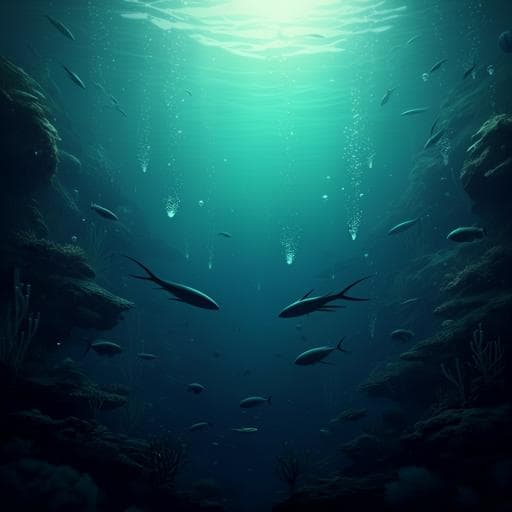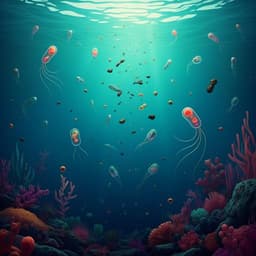
Environmental Studies and Forestry
Science governs the future of the mesopelagic zone
A. Schadeberg, M. Kraan, et al.
This research conducted by Amanda Schadeberg, Marloes Kraan, Rolf Groeneveld, Damian Trilling, and Simon Bush delves into the mesopelagic zone's significance, highlighting its twin roles in fish resource exploitation and carbon sequestration. The study emphasizes the importance of governance in shaping our understanding of this vital ecosystem's future.
~3 min • Beginner • English
Introduction
The mesopelagic zone (200–1000 m) is one of the largest yet least understood ocean ecosystems. Scientific engagement dates back to the Challenger expedition and the discovery of deep scattering layers, with intermittent fishery explorations since the 1970s. Interest has accelerated in the 21st century, largely funded by the EU and US. Scientists argue that new knowledge is needed to understand the mesopelagic’s roles in climate regulation and food systems, yet current estimates are highly uncertain (e.g., global carbon sequestration via the biological pump estimated at 2–6 Gt C yr−1; fish biomass estimates ranging from 1.8 to 19.5 Gt). The authors frame science as rendering nature legible for governance, noting that beyond de jure, state-led regulation, science can exert de facto governing power by shaping what issues are studied, how ecosystems are quantified, and which management pathways appear feasible. Given growing interest but little formal policy specific to the mesopelagic, the study asks how scientific and public discourse construct the mesopelagic zone and with what implications for governance. The authors analyze scientific abstracts and tweets to identify key topics and their interconnections (a network of meaning), and compare them to coverage in key policy documents.
Literature Review
Background literature highlights the chronic under-exploration of deep pelagic ecosystems and the rapid growth of mesopelagic research. Prior work documents wide uncertainty in mesopelagic carbon sequestration and fish biomass estimates, and discussions about potential fisheries, trophic roles, and carbon pump dynamics. Social science literature is used to theorize science’s role in constructing governance objects and de facto governance through authoritative assessments and legibility. The paper situates its contribution within scholarship on agenda setting, framing, semantic/convergence networks, and ocean governance, noting gaps in explicit policy treatment of the mesopelagic and limited public engagement outside of scientific communication.
Methodology
Data sources: The study analyzed three corpora. (1) Scientific abstracts: 2395 Web of Science records retrieved with search terms “mesopelagic” OR “ocean twilight zone” up to 12/31/2020; 2226 abstracts retained after excluding items without abstracts and pre-1990 records. (2) Twitter: Using the same terms and hashtags (#Mesopelagic, #OceanTwilightZone) via the R package AcademicTwitteR, 8690 original tweets (03/21/2009–12/31/2020) were retrieved; 4066 unique, content-bearing tweets retained after removing duplicates/retweets/bots and tag-only/emoticon-only posts. (3) Policy documents: A purposive sample of 15 global and major regional instruments (UN, EU, US) relevant to high seas, EEZs, migratory stocks, and biodiversity that could intersect with the mesopelagic (full list in Supplementary Table 2).
Text preprocessing: Abstracts and tweets were combined into a single corpus. All text was lowercased; stopwords (R package stopwords v2.3) plus additional dataset-specific stopwords, numbers, punctuation, and hashtags were removed.
Topic modeling: A Latent Dirichlet Allocation (LDA) topic model was fit using R’s topicmodels package. The optimal number of topics (k=13) was selected using Idatuning::FindTopicsNumber() across 5–20 topics and four coherence metrics, choosing k where disagreement across metrics was minimal. A low asymmetric alpha (1/k with k=13) was used given short texts and expected dominance of a few topics. Model robustness checks are in Supplementary Figs. 6–11. Human validation via oolong’s topic intrusion tests (three model variants: default, low symmetric alpha, low asymmetric alpha) with six blinded testers showed strong coherence (p-values < 1e−22). Top-ten keywords and beta scores per topic are reported (Fig. 1). Known limitations include the Bag-of-Words approach not capturing word order, negation, or synonymy.
Network of meaning: Following Su et al., the top-ten keywords for each topic were compiled into a dictionary and applied to the corpus to produce a topic-by-document occurrence matrix. Co-occurrences across the 78 unique topic pairs were counted as the number of texts containing keywords from both topics. To reduce visualization noise, only edges with >30,000 shared keyword occurrences were retained. Edge widths and node sizes were normalized to account for differing text lengths/frequencies between tweets and abstracts. The network was visualized with igraph (Fruchterman–Reingold layout).
Policy analysis: The policy corpus was searched using the 130 topic keywords (13 topics × 10 words). Frequencies per document were recorded, and keyword-in-context (kwic) queries conducted using quanteda. The presence/absence and frequency of mesopelagic-relevant terms were compared against the scientific and Twitter topic landscape.
Key Findings
- Thirteen latent topics were identified across 2226 scientific abstracts and 4066 tweets. Two dominant thematic clusters emerged: (1) a fish-focused cluster (diet/foraging, reproduction/growth, distribution/biomass, diel vertical migration/acoustics) and (2) a carbon-focused cluster (particulate organic carbon flux/export and dissolved organic carbon processes). Bridging topics involved zooplankton distributions and microbial/genetic diversity; satellite topics included stable isotope analysis, species classification, and public communication.
- Twitter-dominant topics were less internally coherent and heavily featured institutional communicators (NASA, WHOI, NSF), indicating social media’s role primarily as an extension of scientific communication rather than a venue for counter-narratives.
- The fish cluster contains management-relevant keywords (biomass, distribution, larval growth, size, length, weight), reflecting quantification that renders mesopelagic fish legible for potential fisheries governance.
- The carbon cluster highlights the mesopelagic’s role in the biological carbon pump at particulate and dissolved organic carbon scales, with a Twitter-heavy topic linking carbon discourse to ideas about fisheries and biodiversity.
- Policy gap: Across 15 key ocean governance instruments, the terms “mesopelagic,” “ocean twilight zone,” or “midwater” do not appear. Of the 130 topic keywords, 62 appear at least once; “fish” and “fisheries” are most frequent, reflecting policy focus on fish extraction/protection. “Carbon” appears only once (blue carbon context), indicating little policy uptake of mesopelagic carbon sequestration functions. Microbial/genetic resource topics are also absent in policy coverage.
- Overall, in the absence of de jure mesopelagic-specific policy, scientific discourse—both in publications and via social media—plays a de facto governing role by shaping how the mesopelagic zone is known and which management pathways seem plausible.
Discussion
The analysis shows that scientific work structures the network of meaning around the mesopelagic, centering on fish exploitation potential and carbon sequestration. By quantifying organisms (biomass, distribution, growth) and processes (carbon flux), science renders the mesopelagic legible for governance, anticipating management instruments such as stock assessments or blue/fish carbon schemes. Twitter largely amplifies these scientific narratives rather than diversifying them, likely due to scientists’ exclusive access to deep-sea technologies and limited current economic activity in the mesopelagic attracting few alternative public voices. Notably absent from the topic model are economic cost–benefit assessments, cultural significance, political and social science perspectives, and links to deep-sea mining impacts—highlighting a narrow focus that can prefigure policy debates. The authors argue that this de facto governance by science should be opened to scrutiny and democratized, proposing routes through more transparent and accountable RFMOs/ISA processes, integration with open digital observation platforms (e.g., Global Fishing Watch) to enable dynamic ocean management and broader citizen engagement, and development of a unified global ocean governance infrastructure (GOOS, and a ratified BBNJ treaty) to standardize data collection and participation. Broadening epistemic inputs beyond natural science and beyond traditional state-science interfaces is posited as essential for legitimate, equitable deep-sea governance.
Conclusion
Science currently serves as a de facto governing actor for the mesopelagic zone by defining dominant meanings—fish resources and carbon sequestration—and by communicating these to publics and policymakers in the absence of explicit de jure regulation. Computational topic modeling and network analysis reveal how these narratives cohere and are amplified on Twitter, while policy documents lag in recognizing mesopelagic-specific issues, particularly carbon and microbial/genetic resources. The authors call for democratizing this de facto governance by increasing transparency and participation in existing institutions (RFMOs, ISA), leveraging open digital platforms for observation and engagement, and advancing unified, data-driven global governance (GOOS, BBNJ). Methodologically, they note opportunities to scale analyses to grey literature and advocacy texts and to adopt advanced NLP methods that handle negation and synonymy. Such steps can broaden the range of values, uses, and trade-offs considered for the mesopelagic, leading to more legitimate policy outcomes.
Limitations
- Topic modeling limitations: Bag-of-Words approach does not capture word order, negation, or synonymy; may reduce interpretive nuance and merge distinct concepts.
- Corpus scope: Only scientific abstracts (not full texts) and English-language tweets were analyzed up to 12/31/2020; may omit relevant content and later developments.
- Policy sample: Purposive selection of 15 global/EU/US instruments may not capture national or other regional policies; analysis was largely monolingual and keyword-based.
- Thresholding/visualization: Network edges retained only above a high co-occurrence threshold (>30,000), potentially omitting weaker but meaningful connections.
- Topical coverage: Economic, cultural, and political dimensions of the mesopelagic appear underrepresented in the corpus, potentially biasing identified themes toward natural science perspectives.
Related Publications
Explore these studies to deepen your understanding of the subject.







